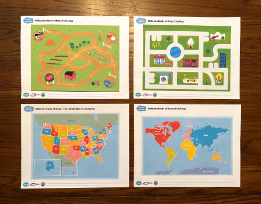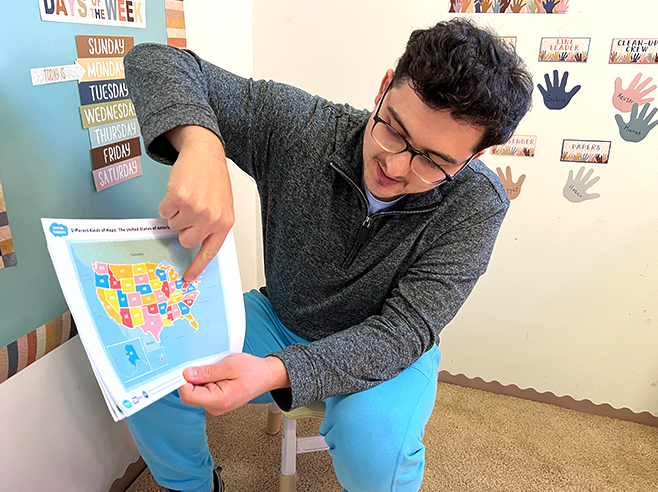Children view different kinds of maps and compare them.
Materials

- Set of four maps: farm map, city map, a United States of America map, and a world map (PDF)
- Computer and projector and a whiteboard or blank wall (optional)
Preparation
- Decide whether you want to cover all four maps in one session or break up this activity over several days. You might feature two maps on one day, and the other two on the next.
- Decide whether to print out copies of the maps for 3–4 children to share in small groups or to use a computer and projector to project the maps on a wall or whiteboard so the whole group can look at them together.
- If printing maps, make enough sets so several children will be able to view them together. Keep a set for yourself. You might hang them on a wall, place them on the floor, or prop them on a whiteboard ledge.
- If possible, laminate the maps so they can be used later in small groups.
Directions
- Ask children to reflect on what they’ve already learned:
- What’s a map? (A small picture of a place in the real world. Example: A map of your street would show where you live and where your neighbors live.)
- What’s a landmark on a map? (A small picture on a map that shows where real places are located in the world. Example: A map of your street would show your home on it — that’s a landmark.)
- Farm Map: Project the first map on a screen. If using paper copies, pass out copies of the farm map to small groups of 3 or 4, so all children can get a good look at it. Ask children:
- What do you think this is a map of? Why do you think that? (Have children name some of the landmarks that indicate it’s a map of a farm.)
- Talk about how maps help us find places and can show us how to get to those places. Point to the cow on the map and say, If the cow wanted to visit the ducks, what path would the cow follow?
- City/Town Map: Pass out copies or project the City/Town map on a screen. Ask:
- What do you think this is a map of? Why do you think that? (Have children point out some of the landmarks that indicate it’s a town or city.)
- Point to the playground on the map, and ask: Here’s a landmark on the map. What’s this a picture of? Pretend you just moved to this town and didn’t know where the playground was. How could a map help you?
- United States of America Map: Pass out copies or project the United States map on a screen. Ask:
- Does anyone know what this is a map of? (Our country, the United States of America.)
- What do you think these lines mean? (They are state lines that show us the borders of each state.)
- Does anyone know where our state is? I’m going to point out where we live in the state.
- World Map: Pass out or project the World map on a screen. Ask:
- What do you think this is a map of? Why do you think that?
- Talk about how big the world is and that the landmarks on this map include oceans and countries. Ask children to point out what is land and what are the oceans.
- Can someone point to where the United States of America is on the world map? (If not, point to it, and then point to the part of the country you are located in.)
- Take this opportunity to ask children if they have family or friends located in different parts of the world. Point out the locations on the map that they mention and say, You can tell your family we located location on the map today!
